Meade DS-2000 User Manual
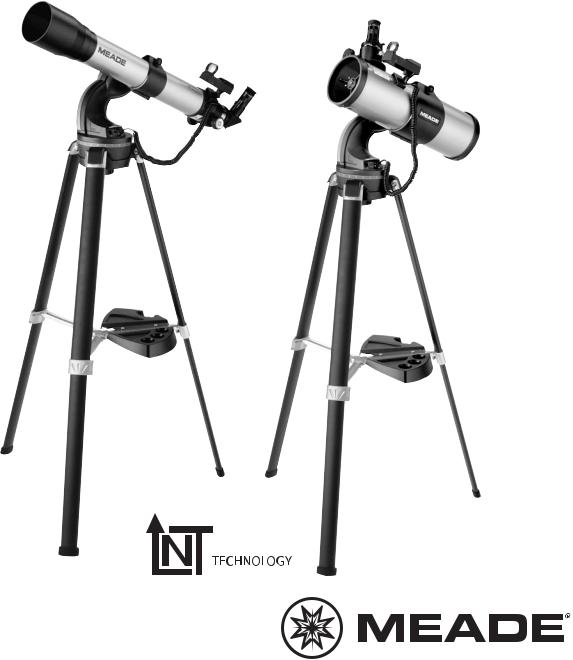
Instruction Manual
DS-2000 Series
Reflecting and Refracting Telescopes
AutoStar® — LNT™ — SmartFinder™





 ™
™
MEADE.COM

 WARNING!
WARNING!
Never use a Meade® DS2000™ Telescope to look at the Sun!
Looking at or near the Sun will cause instant and irreversible damage to your eye. Eye damage is often painless, so there is no warning to the observer that damage has occurred until it is too late. Do not point the telescope at or near the Sun. Do not look through the telescope or SmartFinder™ as it is moving. Children should always have adult supervision while observing.

WARNING!
Never use a Meade® Telescope to look at the Sun! Looking at or near the Sun will cause instant and irreversible damage to your eye. Eye damage is often painless, so there is no warning to the observer that damage has occurred until it is too late. Do not point the telescope or its viewfinder at or near the Sun. Do not look through the telescope or its viewfinder as it is moving. Children should always have adult supervision while observing.
CAUTION:
Use care to install batteries as indicated by the battery compartment. Follow battery manufacturer's precautions. Do not install batteries backward or mix new and used batteries. Do not mix battery types. If these precautions are not followed, batteries may explode, catch fire, or leak. Improperly installed batteries void your Meade warranty.
If you are anxious to use your DS Astro Telescope for the first time, before a thorough reading of this instruction manual, see the QUICK-START GUIDE on page 4.
IMPORTANT NOTE:
DS-2000EC users, see APPENDIX E, page 41, for information about your supplied Electronic Controller. Autostar information does not apply.
DS-2000EC users may obtain the #494 Autostar handbox as an optional accessory. See page 42 for more information.
® The name “Meade,” “AutoStar,” and the Meade logo are trademarks registered with the U.S. Patent Office and in principal countries throughout the world. All rights reserved.
™ “LPI” and “Tonight’s Best” are trademarks of Meade Instruments Corporation.
Patents:
US 7,092,156 and US 7,079,317
Other Patent Pending
© 2005 Meade Instruments Corporation.
CONTENTS |
|
Quick-Start Guide .......................................................... |
4 |
Telescope Features ...................................................... |
7 |
Autostar Features .......................................................... |
9 |
Getting Started .............................................................. |
11 |
Packing List .............................................................. |
11 |
How to Assemble Your Telescope ............................ |
11 |
Using Smartfinder .................................................... |
12 |
Aligning Smartfinder ............................................ |
13 |
Choosing an Eyepiece ............................................ |
14 |
The Barlow Lens ...................................................... |
14 |
Observing ...................................................................... |
14 |
Observing by Moving the Telescope Manually ........ |
14 |
Terrestrial Observing ................................................ |
15 |
Observing Using Autostar's Arrow Keys .................. |
15 |
Slew Speeds ............................................................ |
15 |
Observe the Moon .................................................... |
16 |
Astronomical Observing ............................................ |
16 |
To Track an Object Automatically.............................. |
16 |
Moving Through Autostar’s Menus...................... |
16 |
Initializing Autostar .............................................. |
17 |
Observe a Star Using Automatic Tracking .......... |
18 |
Automatic Alignment ................................................ |
18 |
Go To Saturn ............................................................ |
19 |
Take a Guided Tour .................................................. |
19 |
Basic Autostar Operation................................................ |
20 |
Autostar Navigation Exercise .................................... |
20 |
Entering Numbers and Text into Autostar ................ |
21 |
Navigating Autostar .................................................. |
21 |
Adjusting the Speed of a Scrolling Message ............ |
21 |
Menus and Menu Options .............................................. |
22 |
Complete Autostar Menu Structure .......................... |
22 |
Object Menu.............................................................. |
23 |
Event Menu .............................................................. |
24 |
Glossary Menu .......................................................... |
24 |
Utilities Menu ............................................................ |
24 |
Setup Menu .............................................................. |
26 |
Optional Accessories ...................................................... |
29 |
Caring for Your Telescope ............................................ |
30 |
Collimation ................................................................ |
30 |
Meade Customer Service ........................................ |
32 |
Specifications ............................................................ |
33 |
Appendix A: Celestial Coordinates ................................ |
35 |
Locating the Celestial Pole ...................................... |
35 |
Appendix B: To Find Objects Not in the Database ........ |
36 |
Appendix C: Observing Satellites .................................. |
37 |
Appendix D: Training the Drive ...................................... |
38 |
Appendix E: Battery Replacement ................................ |
39 |
Appendix F: How to Manually Set the Time and Date .. |
40 |
Appendix G: Electronic Controller (DS-2000EC Users Only).. |
41 |
Optional #494 Autostar for DS-2000EC Users ........ |
42 |
Basic Astronomy ............................................................ |
43 |
3
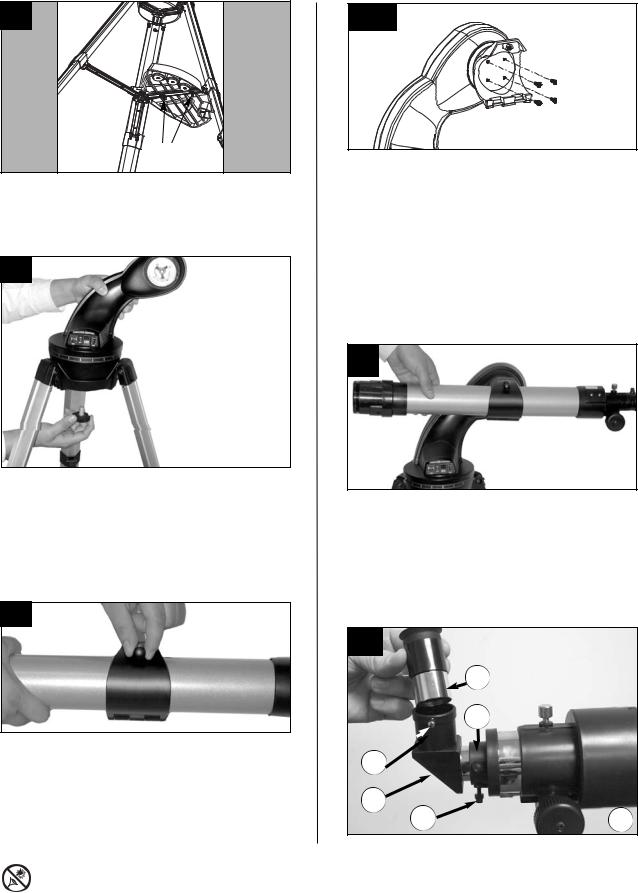
QUICK-START GUIDE
1 |
Fasten |
wingnuts |
1.Open the tripod: Remove the tripod from the giftbox and stand vertically. Gently pull the legs apart to a fully open position. Attach the tray to the tripod: Slide the bolts through the tray and struts. Thread the wingnuts onto the bolts.
2
2.Attach the mounting arm assembly: Place the mounting arm assembly into the tripod base. Reach underneath and thread the mounting knob through the tripod base and into the mounting arm assembly. Tighten to a firm feel only, do not overtighten. While observing, you may wish to slightly loosen this knob and rotate the mounting arm assembly with attached optical tube (see step #6 below) around the horizontal axis.
3
3.Remove the optical tube assembly from the cradle rings: The optical tube assembly is shipped with the cradle rings attached. The rings need to be removed so they can be attached to the mounting arm. Loosen the cradle lock knob until you can open the cradle rings. Remove the optical tube assembly from the cradle rings.
4 & 5 |
4.Remove 4 screws from the mounting arm shaft: Locate the four screws on the mounting shaft. Remove the screws using a "+" (Phillips head) screwdriver.
5.Attach the cradle to the mounting arm: Line up the cradle with the mounting arm shaft. The cradle contains a molded "key" that fits into a slot on the shaft. Line up the key and the slot, and slide the cradle onto the shaft. This automatically lines up the mating threads on the cradle with the ones on the shaft. Replace the four screws you removed in step #4 into the mating threads as depicted in the diagram above.
6
6.Attach and balance the optical tube: Replace the optical tube into the cradle ring. Tighten the cradle rings lock knob so that it holds the optical tube loosely; do not tighten the cradle ring lock knob at this point. Slide the tube back and forth until you find a position where the tube remains horizontal (i.e., without tipping up and down). Tighten the cradle rings lock knob to a firm feel.
7a
D
A
F
B
C  E
E
Looking at or near the Sun will cause irreversible damage to your eye. Do not point this telescope at or near the Sun. Do not look through the telescope as it is moving.
4
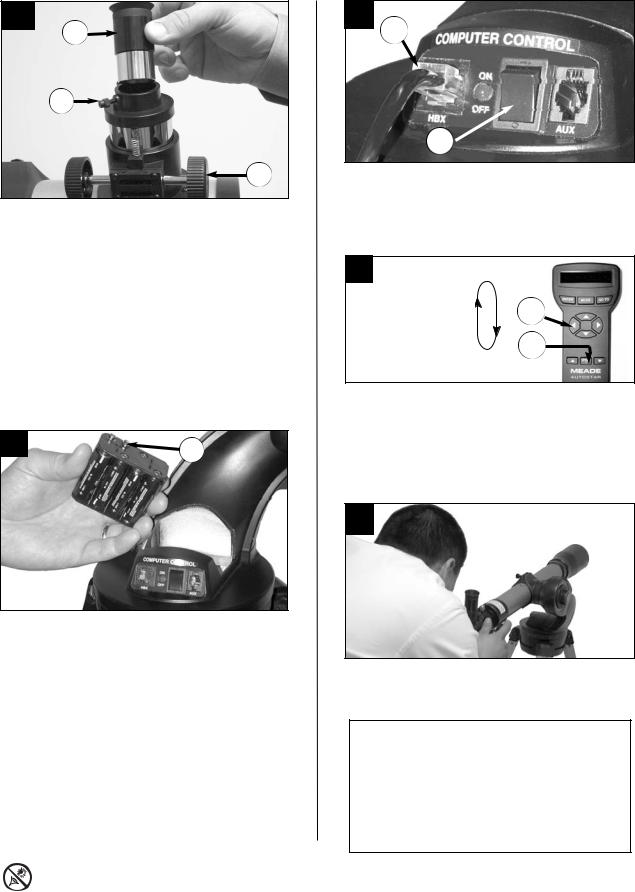
7b
D
F
E
7a. Attach the 90° diagonal prism (refractor models only, see inside front cover): Pull out to remove the plastic dust cover from the eyepiece holder
(A). Slide the tube of the diagonal prism (B) into the telescope’s eyepiece-holder and tighten the thumbscrews (C) to a firm feel only to secure.
7b. Insert the eyepiece: Remove the supplied 25mm or 26mm eyepiece (D) from its container and place it in the diagonal prism (refractor models only; see Fig. 7a) or directly into the eyepiece holder (reflector models only; see Fig. 7b).
Tighten the thumbscrews (F) to a firm feel only. Remove the dust cover from the end of optical tube assembly. Use the focus knobs (E) to bring objects into focus.
8
G
8.Insert batteries: Open the battery compartment by lifting the cover and pulling it away from the drive base.
Remove the battery holder from the compartment and carefully lift the 9v connector out from the compartment. Whenever you replace the batteries, to safeguard the wires, disconnect the 9v connector (G) from the battery holder before removing the batteries.
. Insert eight AA-size batteries into the battery holder, oriented as shown on the diagram on the battery slots of the battery holder. Connect the 9v connector plug to the battery holder. Carefully replace the battery holder back into the battery compartment. Replace the cover.
9
I
H
9.Connect Autostar: Be certain that the power switch (H) on the computer control panel is in the OFF position. Plug the coil cord of the Autostar Controller into the HBX port (I). Turn on the computer panel; the red LED lights when power is supplied to the panel.
10 |
Slew Speed: |
|
|
|
|
|
Fast |
|
|
. |
|
|
. |
J |
|
. |
|
|
Medium |
|
|
. |
|
|
. |
|
|
. |
K |
|
Slow |
10.Change Speeds: Press the key prompted by Autostar to accept the Sun warning. You can now use the Arrow keys (J) to move the telescope up, down, right, or left. To change one of the telescope's nine slew speeds, briefly press the SPEED/? key (K). Each press decreases the slew speed down one level, and then will cycle back to the fastest speed.
11
11.Sight along the tube: Sight along the side of the telescope's main tube to locate an object. Practice using the Autostar Arrow keys to center an object in the telescope's field of view.
If you wish to attach Smartfinder, see page 11. If you wish to initialize Autostar, see page 17. If you wish to align the telescope, go to page
18.
If you wish to use Autostar to view Saturn, go to page 19.
Looking at or near the Sun will cause irreversible damage to your eye. Do not point this telescope at or near the Sun. Do not look through the telescope as it is moving.
5
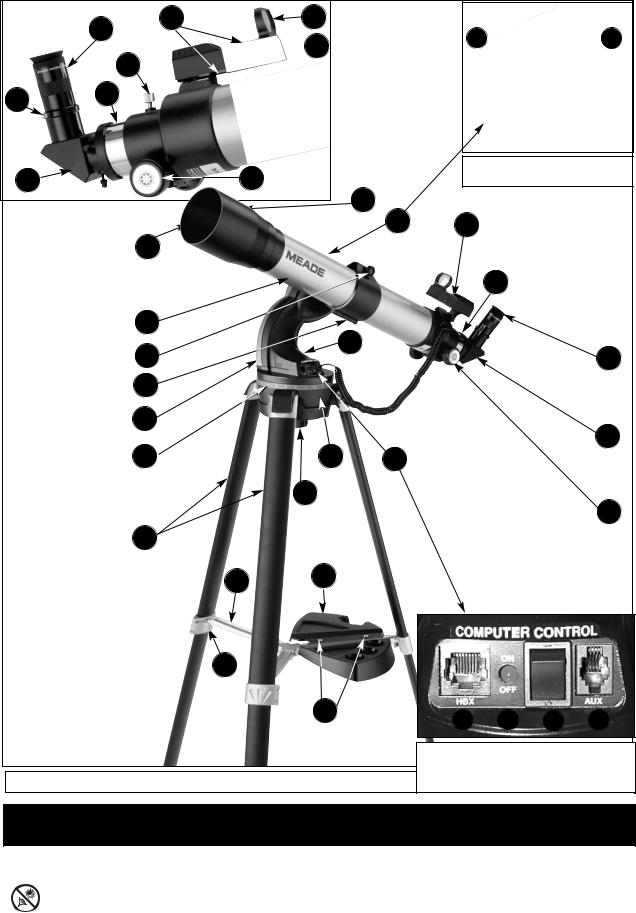
8 |
other |
9 |
|
side |
|||
5 |
|
||
|
|
 7
7
6
4 2
|
3 |
1 |
|
|
12 |
|
|
(not visible) |
1. |
Focus Knob |
13 |
|
||
2. |
Eyepiece Holder |
|
3. |
90° Diagonal Prism |
14 |
|
(refractors only) |
|
4. |
Eyepiece Holder |
15 |
|
Thumbscrew |
|
|
|
|
5. |
Eyepiece |
16 |
6. |
Focus Lock Knob |
7.Smartfinder-LNT Module
8.Smartfinder
|
Alignment Screws |
24 |
9. Smartfinder Lens |
|
|
10. Altitude Setting Circle |
|
|
|
and Lock |
|
11. Dew Shield |
|
|
12. |
Dust Cap |
|
13. |
Optical Tube |
22 |
14.Cradle Ring Lock Knob
15.Cradle Ring
16.Mounting Arm and Shaft
17.Computer Control Panel
18.Accessory Tray Attachment Bolts
19.Accessory Tray
20. Inner Support Struts
21.Tripod Legs Locks
22.Tripod Legs
23.Tripod Base
24.Azimuth Setting Circle
25.Battery Compartment
26.Base Lock Knob
Fig. 1: DS-2000 Series Telescope.
E F
Fig. 1b (Inset): (E) Altitude Setting
Circle; (F) Altitude Lock
5
3
1
A B C D
Fig. 1c (Inset): Computer Control Panel. (A) Handbox port; (B) Power indicator light, (C) ON switch; (D) Auxiliary port.
Features of the DS-2000 Series telescopes are virtually identical. Certain features of your telescope may look different than, or be positioned slightly different than the one pictured here, but the functionality of the features is the same.
Looking at or near the Sun will cause irreversible damage to your eye. Do not point this telescope at or near the Sun. Do not look through the telescope as it is moving.
6

TELESCOPE FEATURES
Take the time to become acquainted with all of these controls before attempting observations through the telescope.
1Focus Knob: Moves the telescope’s focus drawtube in a finely-controlled motion to achieve precise image focus. Rotate the focus knob clockwise to focus on distant objects, and counterclockwise to focus on nearby objects.
2Eyepiece Holder: Holds the eyepiece in place. On refractor models, also holds the 90° diagonal prism in place.
390° Diagonal Prism (refractor models only): Holds the eyepiece upright for easy viewing. Results in an upright, but reversed viewing of land objects.
4Eyepiece Holder Thumbscrew: Tightens the eyepiece in place. Tighten to a firm feel only.
5Eyepiece: Place the supplied eyepiece into the eyepiece holder (reflector models only) or the 90° Diagonal Prism (refractor models only, 3, Fig. 1) and tighten in place with thumbscrew (4, Fig.1).
6Focus Lock Knob: Designed to prevent the focuser drawtube from moving when a heavy accessory, such as a camera, is attached to the focuser assembly. For normal observing with an eyepiece and diagonal prism, it is not necessary to use the lock knob.
7Smartfinder - LNT Module: Provides an easier way to initially sight objects than the main telescope eyepiece which has a narrower field of view. You may blink the red dot off and on. See pages 12-13.
8Smartfinder Alignment Screws: Adjust these screws to align the Smartfinder. See page 13 for more information.
9Smartfinder Lens: The red dot is projected onto this lens.
10 Altitude Setting Circle and Lock
A) Altitude Setting Circle: Displays Altitude (vertical) coordinates (A, Fig. Ib).
B) Altitude Lock: Controls the manual vertical movement of the telescope. Turning the Altitude lock counterclockwise unlocks the telescope enabling it to be freely tilted by hand on the vertical axis. Turning the Altitude lock clockwise (to a firm feel only) prevents the telescope from being moved manually and engages the vertical motor drive clutch for Autostar operation (B, Fig. Ib).
11Dew Shield: Reduces dew formation on the telescope's primary lens (refractor models only).
12Dust Cap: Pull to remove the dust cap from the front lens of the telescope.
Note: The dust cap should be replaced and the power turned off to the telescope after each observing session. Verify that any dew that might have collected during the observing session has evaporated before replacing the dust cap.
13Optical Tube: The main optical component that gathers the light from distant objects and brings this light to a focus for observation with the eyepiece.
14Cradle Ring Lock Knob: Tighten to a firm feel to hold the optical tube securely in place.
15Cradle Ring: Holds optical tube in place. Attaches to the mounting arm shaft (16, Fig. 1)
16Mounting Arm and Shaft: Holds the optical tube assembly. Attaches to the tripod base (23, Fig. 1).
17Computer Control Panel (Fig. Ic)
A.Handbox (HBX) Port: Plug the #494 Autostar handbox (AT models) or the Electronic Controller (EC models) into this port.
B.LED: The red power indicator light illuminates when power is supplied to the connected handbox and to the telescope’s motor drive.
C.ON Switch: Press to turn the Computer Control Panel and Autostar ON or OFF.
Note: Always remove the batteries if they are not to be used for a long period of time.
D.Auxiliary (AUX) Port:Provides connection for current and future Meade accessories. See OPTIONAL ACCESSORIES, page 29.
Looking at or near the Sun will cause irreversible damage to your eye. Do not point this telescope at or near the Sun. Do not look through the telescope as it is moving.
7
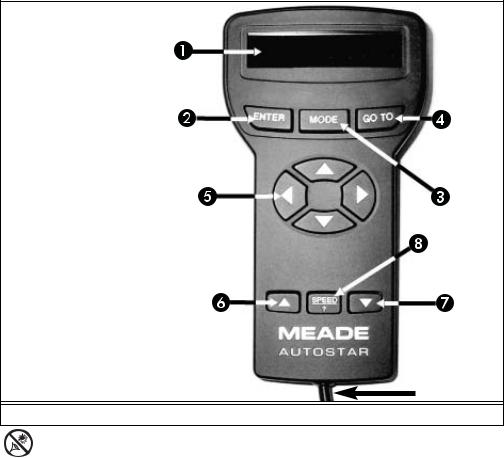
18Accessory Tray Attachment Bolts - Attach to wing nuts to fasten tray to the tripod. See page 11 for more information.
Note: It is not necessary to remove the tray each time you collapse the tripod. The tray is designed to be collapsed with the legs.
19Accessory Tray - Conveniently holds extra eyepieces, Autostar handbox, and other accessories.
20nner Support Struts (3) - Make the tripod more secure and stable.
21Tripod Legs Locks (3) - Lift the lock up to loosen inner section of a tripod leg and extend the inner leg to desired height. Press the lock down to lock the leg in place.
22Tripod Legs - Spread the legs out as far as they will open for a secure viewing platform.
23Tripod Base - Holds the mounting arm assembly (16, Fig. 1) in place.
24Azimuth Setting Circle - Displays Azimuth (horizontal) coordinates.
25Battery Compartment - Install eight user-supplied AA batteries in this compartment. See page 12 for more information.
26Base Lock Knob (not visible in photo) - Attaches mounting arm assembly to tripod base. Loosen before moving the optical tube on the horizontal axis. See page 11 for more information.
1.Liquid Crystal Display (LCD)
2.ENTER Key
3.MODE Key
4.GOTO Key
5.Arrow Keys
6, 7. Scroll Keys
8.Speed/? Key
9.Coil Cord
j
Fig. 2: #494 Autostar Handbox.
Looking at or near the Sun will cause irreversible damage to your eye. Do not point this telescope at or near the Sun. Do not look through the telescope as it is moving.
8
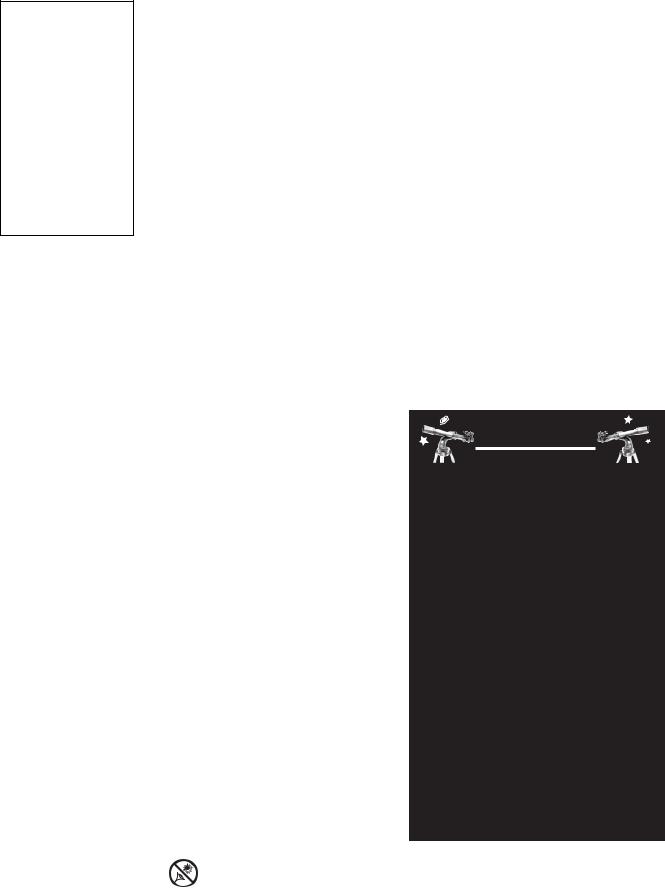
NOTE: DS-2000EC users, see APPENDIX E,
page 39, for information about your supplied Electronic Controller. Autostar information does not apply.
DS-2000EC users may obtain the #494 Autostar handbox as an optional accessory. See page 42 for more information.
AUTOSTAR FEATURES
The #494 Autostar controls the DS-2000AT Series Telescopes. Nearly all telescope operations are accomplished with just a few pushes of Autostar’s buttons. Some of the major features of Autostar are:
■Automatically move the telescope to any of the 1400 objects stored in the database or manually enter the astronomical coordinates of any celestial object.
■Take a guided tour of the best celestial objects to view on any given night of the year.
■Access a glossary of astronomical terms.
■Calculate which eyepiece to use for optimum viewing of a celestial object.
The Autostar Computer Controller provides control of virtually every telescope operation. Autostar has soft-touch keys designed to have a positive feel. The LCD (Liquid Crystal Display) is backlit with a red LED (Light Emitting Diode) for easy viewing in the dark. The backlit display, key arrangement, and sequential database make Autostar extremely user friendly.
NOTE: Autostar does not require batteries; the telescope’s batteries supply power to Autostar.
12-Line LCD Display - Provides an visual interface between Autostar and the telescope.
•Top line: Displays a menu.
•Bottom line: Displays a menu option or information about an object or subject, depending on what operation is being performed.
2ENTER Key - Selects a choice or accesses the next menu or level. This is similar to a Return key on a computer. See MOVING THROUGH AUTOSTAR'S MENUS, page 16 and
MENUS AND MENU OPTIONS, page 22.
NOTE: If ENTER is pressed and held for two seconds or more and then released, Autostar emits a beep and “ENTER to Sync” is displayed. "ENTER to Sync" can only be used after the telescope has been aligned and is pointing at an object. If the "ENTER to Sync" feature is  accessed by mistake, press MODE
accessed by mistake, press MODE 



to return to the previous screen. See HIGH PRECISION, page 27, for more
details about this feature.
3 MODE Key - Returns to the previous menu or level. The MODE key is similar to the ESCAPE key on a computer.
NOTE: Pressing MODE while in the “Select Item” level moves Autostar to the topmost screen: “Select Item:
Object.”
NOTE: If MODE is pressed and held for two seconds or more, the following information displays :
• Azimuth and Altitude
(astronomical) coordinates
• Altitude (vertical) and Azimuth
(horizontal) coordinates
• Local Time and Local Sidereal
Time (LST)
• Timer and Alarm Status
Press MODE again to return to the previous menu.
Looking at or near the Sun will cause irreversible damage to your eye. Do not point this telescope at or near the Sun. Do not look through the telescope as it is moving.
9

DEFINITION:
Throughout this manual, you will notice the term "Alt/Az." Alt/Az (short for altazimuth) just means that your telescope moves up and down and from side to side. Alt/Az is one of many methods used by amateur astronomers to locate celestial objects.
Fasten |
wingnuts |
Fig. 3 Attach Tray to the tripod: Thread the wingnuts to the bolts (bottom view).
Fig. 4: Pads allow the mount to move smoothly.
4GO TO Key - Slews (moves) the telescope to a selected object. While the telescope is slewing, the operation may be aborted at any time by pressing any key except GO TO. Pressing GO TO again resumes the slew to the object.
The GO TO key also allows you to perform a "spiral search." A spiral search is useful during alignment after the telescope slews to an alignment star, but the star is not visible in the eyepiece when the telescope finishes its search. Press GO TO when the slew is finished and the telescope starts slewing in a spiral pattern at a very slow speed around the search area. Look through the eyepiece and when the object does become visible, press MODE to stop the spiral search. Then use the Arrow keys to center the object.
5Arrow Keys - Move the telescope in a specific direction (up, down, left, and right), at any one of nine different speeds. Speed selection is explained in SLEW SPEEDS, page 15. The following operations are also available with the Arrow keys:
•Data Entry - Use the Up and Down Arrow keys to scroll through the letters of the alphabet and numerical digits. The Down Arrow key starts with the letter "A" and the Up Arrow key starts with the digit "9." The Left and Right Arrow keys are used to move the cursor left and right across the LCD display.
•Alt/Az Alignment - Use the Up and Down Arrow keys to move the telescope vertically up and down. The Left Arrow key moves the telescope horizontally counterclockwise, while the Right Arrow key moves it clockwise.
6,7 Scroll Keys - Allows you to scroll through menu options. The menu is displayed on the top line of the screen and the options within the menu are displayed, one at a time, on the second line. Press and hold a Scroll key to move quickly through the options.
The Scroll keys also scroll through the letters of the alphabet and numerical digits.
NOTE: The Scroll Down key and the Down Arrow key move forward through the alphabet & digits (A to Z, 0 to 9). The Scroll Up key and the Up Arrow key move backward (Z to A, 9 to 0). Common symbols are also available in the list.
Tip: When a message is scrolling across the display, press and hold the Up Scroll key to increase the scrolling speed or press and hold the Down Scroll key to decrease the scrolling speed.
8Speed/? Key - Pressing the Speed/? key cycles through the nine slew speeds that move the telescope. Each time the Speed/? key is pressed briefly, the current slew speed is shown for about two seconds on the display. See SLEW SPEEDS, page 15.
The Speed/? key also accesses the "Help" file. "Help" provides on-screen information on how to accomplish whatever task is currently active.
NOTE: Pressing the Speed/? key very briefly changes the slew speed. Holding down the Speed/? key longer (one to two seconds) accesses the Help function.
If you have a question about an Autostar operation, e.g., INITIALIZATION, ALIGNMENT, etc., hold down the Speed/? key and follow the directions that scroll on the second line of the LCD screen.
When a word appears in [brackets], press ENTER to access the Autostar Glossary. A definition or more detailed information is displayed. Press MODE to return to the scrolling Autostar Help display.
When satisfied with the Help provided, press MODE to return to the original screen and continue with the chosen procedure.
9Coil Cord (not shown) - Plug the Autostar coil cord into the HBX port (A, Fig. 1c) of the telescope computer control panel.
Fig. 5: Attach the mounting arm to the tripod base.
Looking at or near the Sun will cause irreversible damage to your eye. Do not point this telescope at or near the Sun.
Do not look through the telescope as it is moving.
10

Fig. 6: Attach cradle to mounting arm.
Fig. 7: Attach and balance the optical tube.
Fig. 8: Slide viewfinder into slip-fit bracket.
Fig. 9: Press down on the quick release tab to detach the viewfinder from the bracket.
GETTING STARTED
Packing List
Getting the telescope ready for first observations requires only a few minutes. When first opening the packing box, note carefully the parts listed on your giftbox.
How to Assemble Your Telescope
The telescope attaches directly to the tripod. The telescope in this way is mounted in an “Altazimuth” (“Altitude-Azimuth,” or “vertical-horizontal”) format. The telescope in this configuration moves up and down and from side to side.
1.Open the tripod: After removing the field tripod from its shipping carton, stand the tripod
vertically, with the tripod feet down and with the tripod still fully collapsed. Gently pull the legs apart to a fully open position.
2.Attach the tray to the tripod: Place the tray (19, Fig. 1) over the inner support strut that contains two bolt holes. Line up the bolts holes on the tray with the bolt holes on the strut. Slide the two included bolts through the top of bolt holes (18, Fig. 1) and tighten the bolts with the included wing nuts on the bottom side of the tray (Fig. 3). Tighten to a firm feel only.
Note: The tray does not have to be removed when you collapse the tripod at the end of a viewing session— just loosen the tray’s center lock knob.
3.Three Pads: There are three pads in the tripod base (23, Fig. 1) and three pads on the mounting arm assembly (16, Fig. 1). These pads allow the mounting arm assembly to move more easily inside the base. See Fig. 4. This is pointed out just for the user's knowledge of
the telescope; the user does not need to adjust the pads which are pre-installed.
4.Attach the mounting arm assembly to the tripod base: Place the mounting arm assembly into the tripod base and continue to hold onto the arm assembly. With your other hand, reach underneath the base and thread the mounting lock knob (26, Fig. 1) through the tripod base and into the mounting arm assembly. Tighten to a firm feel only; do not overtighten. While observing, you may wish to loosen this knob and rotate the mounting arm assembly and optical tube (see step #8) on the horizontal axis.
5.Remove the optical tube assembly from the cradle rings: The optical tube assembly is shipped with the cradle rings attached. The rings need to be removed before they can be attached to the mounting arm. Loosen the cradle lock knob (14, Fig. 1) until you can open the cradle rings. Remove the optical tube assembly (13, Fig. 1) from the cradle rings.
6.Remove 4 screws from the mounting arm shaft: Locate the four screws on the mounting shaft. Remove the screws using a "+" (Phillips head) screwdriver. Set the screws aside.
7.Attach the cradle to the mounting arm: Line up the cradle with the mounting arm shaft. The cradle contains a molded "key" that fits into a slot on the shaft. Line up the key and the slot, and slide the cradle onto the shaft. This automatically lines up the mating threads on the cradle with the ones on the shaft. Replace the four screws into the mating threads using the Phillips head screwdriver (Fig. 6). The key and slot on the shaft set limit stops for the telescope so that it doesn't strike the base or pass beyond approximately 90° upright when you use the Autostar handbox.
8.Attach and balance the optical tube: Replace the optical tube into the cradle ring. Tighten the cradle ring lock knob so that it holds the optical tube loosely; do not tighten the cradle ring lock knob at this point. Slide the tube back and forth until you find a position where the tube remains horizontal (i.e., without slightly tipping up or down). Tighten the cradle rings lock knob to a firm feel. See Fig. 7. Adjust the length of the tripod legs to a comfortable viewing height using the leg locks (21, Fig. 1).
9.Attach the red dot viewfinder: The viewfinder has a slip-fit type bracket for easy attachment. Just slide the viewfinder into the bracket until it clicks in place. To detach the bracket, press down on the bracket's quick release tab and slide the bracket out. See Figs. 8 and 9.
10.Attach the 90° diagonal prism (refractor models only): Pull out to remove the plastic dust cover from the eyepiece holder. Slide the tube of the diagonal prism (3, Fig. 1) into the telescope’s eyepiece-holder (2, Fig. 1) and tighten the thumbscrews (to a firm feel only) to secure the diagonal prism in place.
Looking at or near the Sun will cause irreversible damage to your eye. Do not point this telescope at or near the Sun. Do not look through the telescope as it is moving.
11

|
3 |
|
2 |
1 |
4 |
Fig. 10: Attach the diagonal prism (1), tighten prism thumbscrews (2), insert the eyepiece (3), tighten eyepiece thumbscrews (4) (Refractor models).
1 
3 |
2 |
Fig. 11: Insert the eyepiece
(1) into the eyepiece holder (2), tighten eyepiece thumbscrew (3) (Reflector models).
3
2
1
Fig. 12: Insert eight AA-size batteries inside the battery compartment:
(1)Battery compartment
(2)Battery holder
(3)9v connector
11. Insert the eyepiece: Remove the supplied eyepiece (3, Fig. 10) from its container and place it in the diagonal prism (refractor models only; 1, Fig. 10) or directly into the eyepiece holder (2, Fig. 11, reflector models only). Tighten the thumbscrews (2 and 4, Fig. 10, refractor models only) to a firm feel only. Tighten the thumbscrew (3 , Fig. 11, reflector models only) to a firm feel only.
12. Insert batteries: The telescope’s battery compartment (1, Fig. 12) is located on top of the drive base. Open the battery compartment by lifting the cover and pulling it away from the drive base.
Remove the battery holder from the compartment and carefully lift the 9v connector out from the compartment. Take care not to accidentally detach the wires of the battery connector from the base. Whenever you replace the batteries, to safeguard the wires, disconnect the 9v connector from the battery holder before removing the batteries.
Insert eight AA-size batteries into the battery holder, oriented as shown on the diagram on the battery slots of the battery holder. Connect the 9v connector plug to the battery holder. Carefully replace the battery holder back into the battery compartment. Replace the cover.
CAUTION: Use care to install batteries as indicated by the battery compartment. Follow battery manufacturer's precautions. Do not install batteries backwards or mix new and used batteries. Do not mix battery types. If these precautions are not followed, batteries may explode, catch fire, or leak. Improperly installed batteries void your Meade warranty. Always remove the batteries if they are not to be used for a long period of time.
14.Connect Autostar and Smartfinder: Be certain that the power switch on the computer control panel (C, Fig. 1c) is in the OFF position. Plug the coil cord of the Autostar Controller into the HBX port (A, Fig. 1c). Plug the coil cord of the Smartfinder into the AUX port (D,
Fig. 1c). Turn on the power switch; the red LED lights when power is supplied to the panel. Also see Fig. 13.
NOTE: The Autostar handbox does not require batteries; the telescope’s batteries supply power to Autostar.
15.Remove the dust cover: Pull out the dust cover (12, Fig. 1) from the optical tube assembly (13, Fig. 1).
Assembly of the basic telescope is now complete.
Using SmartFinder
As with most astronomical telescopes, an eyepieces presents a narrow field of view to the observer. As a result it is sometimes difficult to locate objects just using your eyepiece. The SmartFinder has a projected red dot that helps you to locate objects as you move your telescope.
To turn on SmartFinder’s red dot (continuous, without blinking):
1.Press and hold MODE for two seconds. R.A and Dec. coordinates display.
2.Keep pressing the Scroll Down key until “Finder Set: Set” displays.
3.Press ENTER. “Finder Set: Intensity” displays.
4.Press the Scroll Down key. “Finder: Blink On” displays.
5.Press ENTER. A time value, in seconds, displays. For example, “00.5” may display “00.5” is the amount of time, in seconds, that the red dot will blink “on.” (For this example, you may select or enter any value except “00.0.”) Press ENTER.
6.Press the Scroll Down key. “Finder: Blink Off” displays.
7.Press ENTER. Use the Number keys to enter “00.0” or press the Scroll Down key until “00.0” displays. “00.0” is the amount of time in seconds that the red dot will remain “off.”
This
value, along with the value you chose in the “Finder: Blink On” menu, allows the red dot to remain on without blinking. “00.0” means there is no “off” time, so the dot will remain on continuously, without blinking.
8. Use these menus to set other blink rates. For example, If you select “00.1” in the Blink Off
Looking at or near the Sun will cause irreversible damage to your eye. Do not point this telescope at or near the Sun. Do not look through the telescope as it is moving.
12
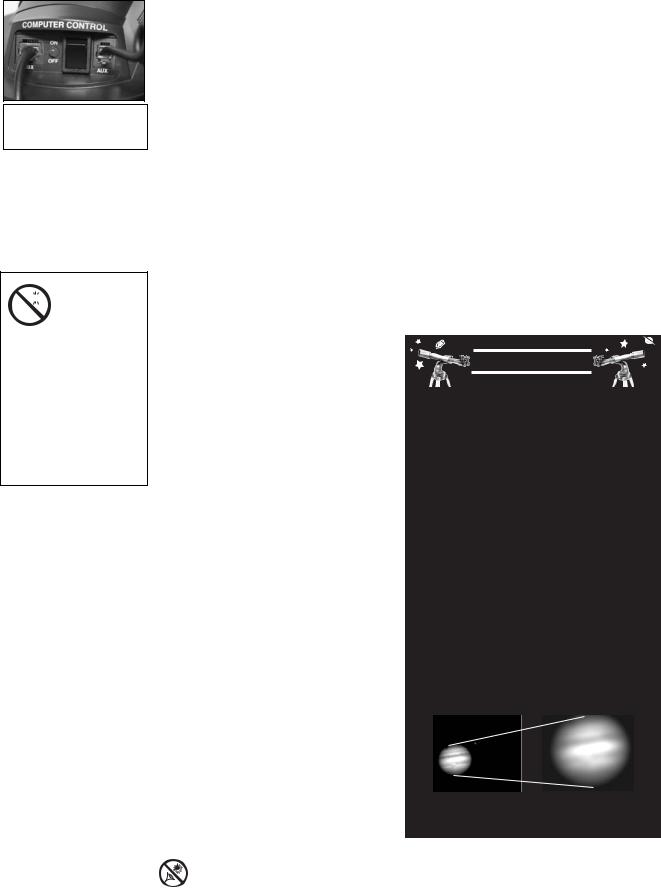
Fig. 13: Connect Autostar to the HBX port and Smartfinder to AUX port.
NEVER point 
 the telescope
the telescope  directly at or near the Sun at any time! Observing
directly at or near the Sun at any time! Observing
the Sun, even for the smallest fraction of a second, will result in instant and irreversible eye damage, as well as physical damage to the telescope itself.
menu, and “00.2” in the Blink On menu, the red dot will blink on for .2 seconds and then blink off for .1 second, and then repeat the cycle until you change the values again.
9. Press and hold MODE to exit this function.
Aligning Smartfinder
Because the main telescope has a fairly narrow field of view, locating objects directly in the main telescope can sometimes be difficult. Smartfinder (7, Fig. 1) projects a small red dot that permits you to more easily locate objects. When Smartfinder and optical tube are aligned to each other, both point to the same position in the sky. An object located in the viewfinder is therefore in the eyepiece of the main telescope.
To align Smartfinder:
It is recommended that you perform steps 1 through 4 of this procedure during the daytime and step 5 at night.
1.Loosen the tripod base lock knob (26, Fig. 1) and the Altitude lock (10, Fig. 1), so that the telescope can move freely.
2.If you have not already done so, place a low-power (e.g., 25mm) eyepiece in the diagonal prism of the main telescope (3, Fig. 1) and point the telescope at an easy-to-find land object
(e.g., the top of a telephone pole or sign). Turn the focuser knob (1, Fig. 1) to focus the image in the eyepiece. Center the object precisely.
3.Re-tighten the tripod base lock knob (26, Fig. 1) and the Altitude lock (10, Fig. 1) so that the telescope does not move during the procedure.
4.Looking through Smartfinder. Turn the Smartfinder’s two alignment screws (8, Fig. 1) until Smartfinder’s red dot points precisely at the same object as centered in the eyepiece. Smartfinder is now aligned to the main telescope.
5.Check this alignment on a celestial object, such as the Moon or a bright star, and make any necessary refinements.
DS-2000 TIPS
Too Much Power?
Can you ever have too much power? If you’re referring to eyepiece power (magnification), yes, you can! The most common beginner’s mistake is to “overpower” a telescope by using too high of a magnification, which the telescope’s aperture and atmospheric conditions cannot reasonably support. Keep in mind that a smaller, but bright and wellresolved image is far superior to one that is larger, but dim and poorly resolved (see below). Powers above 200X should be employed only under the steadiest atmospheric conditions.
Autostar can calculate the best eyepiece for you to use. Try out the “Eyepiece Calc” feature in the Utilities menu.
Most observers should have three or four additional eyepieces to achieve the full range of reasonable magnifications possible with the DS-2000 telescopes. See “OPTIONAL ACCESSORIES,” page 29.
Fig. 14a & 14b: Jupiter; example of too much magnification.
Looking at or near the Sun will cause irreversible damage to your eye. Do not point this telescope at or near the Sun. Do not look through the telescope as it is moving.
13

Fig. 15: 25mm and 9mm eyepieces.
Important Note: When you look through your telescope’s eyepiece, the image might look strange at first.
If you have a refracting telescope, objects will appear right-side-up, but reversed left-for-right. This will not make a difference when observing astronomical objects, and in fact, all astronomical telescopes present inverted images.
During terrestrial observing, when a
corrected image (rightside up and correct left- for-right) is desirable, an optional Meade 45° Erecting Prism is available. See the
OPTIONAL ACCESSORIES, page 29, or consult the Meade Telescope Catalog.
No means of correcting the image is available for reflecting telescopes— the image will appear upside down and reversed left-for-right.
Choosing an Eyepiece
A telescope’s eyepiece magnifies the light gathered by the optical tube. Each eyepiece has a focal length, expressed in millimeters, or “mm.” The smaller the focal length, the higher the magnification. For example, an eyepiece with a focal length of 9mm has a higher magnification than an eyepiece with a focal length of 25mm.
Your telescope comes supplied with a low-powered 25mm or 26mm eyepiece which gives a wide, comfortable field of view with high image resolution. Always begin your observations with this eyepiece.
Low power eyepieces offer a wide field of view, bright, high-contrast images, and eye relief during long observing sessions. After an object is located and centered in the eyepiece, try switching to a higher power eyepiece to enlarge the image.
NOTE: Viewing conditions vary from night-to-night and from site-to-site. Turbulence in the air, even on an apparently clear night, can distort images. If an image appears fuzzy and ill-defined, return to a lower power eyepiece for a more well-resolved image.
The power, or magnification of a telescope is determined by the focal length of the telescope and the focal length of the eyepiece being used. To calculate eyepiece power, divide the telescope's focal length by the eyepiece's focal length. For example, you may wish to use a 25mm eyepiece with the DS-2000 model DS-2114S. Look up the focal length of the DS-2114S under SPECIFICATIONS: DS-2114S, page 33. The focal length is listed as 1000mm.
Telescope focal length divided by Eyepiece focal length = Eyepiece power
1000 v 25 = 40
The eyepiece power, or magnification is therefore 40X (approximately).
The Barlow Lens
Some Meade telescopes include a power multiplier called a Barlow lens. Consisting of a lens mounted in a 4"-long (10cm) tube, the Barlow doubles or triples the power obtained when an eyepiece is used alone. In the example above, a 25mm eyepiece results in 40X magnification with the DS-2114S telescope; when this same eyepiece is used in conjunction with a 2x Barlow lens, power is doubled to 80X. To use the Barlow, insert it into the diagonal prism (refractor models only) or eyepiece holder, followed by the eyepiece.
OBSERVING
Observing by Moving the Telescope Manually
If you wish to observe a distant land object, such as a mountain top or a bird, you can observe by merely pointing the telescope and looking through the eyepiece.
1.Loosen the telescope’s tripod base lock knob (26, Fig. 1) and Altitude lock (6, Fig. 1), so that the telescope can move freely.
2.Point your telescope at distant street signs, mountains, trees, and other structures. Use Smartfinder to help site-in on an object.
3.Center the object using Smartfinder and then in the telescope eyepiece. When the object
is centered in your eyepiece, re-tighten the base and Altitude locks.
4.Practice focusing objects with the focus knob (1, Fig. 1).
5.Once you get a feel for how your telescope moves and focuses, try to view something more challenging, like a bird or a distant moving train.
You can also observe stars and objects in the night sky using this method, but note that objects begin to slowly drift across the eyepiece field. This motion is caused by the rotation of the Earth. As you become familiar with the Autostar handbox operation, you can counteract the drift using the automatic tracking feature in the Autostar Setup menu (see TO TRACK AN OBJECT AUTOMATICALLY, page 18), or by using Autostar's GO TO capabilities (see GO TO SATURN, page 19).
Looking at or near the Sun will cause irreversible damage to your eye. Do not point this telescope at or near the Sun. Do not look through the telescope as it is moving.
14

NOTE:
Do not look through the telescope's eyepiece while it is rapidly moving. Children should always have adult supervision while observing.
TIP: When a message is scrolling across the display, press and hold the Up Arrow key to increase the scrolling speed or press and hold the Down Arrow key to decrease the scrolling speed.
Terrestrial Observing
DS-2000 refracting telescopes are excellent high-resolution, terrestrial (land) telescopes (reflecting telescopes are designed primarily for astronomical observations). Viewing terrestrial objects requires looking along the Earth's surface through heat waves. These heat waves often cause degradation of image quality. Lower power eyepieces, such as a 25mm eyepiece, magnify these heat waves less than higher power eyepieces. Therefore, lower power eyepieces provide a steadier, higher quality image. If the image is fuzzy or ill-defined, reduce to a lower power eyepiece, where the heat waves do not have such an effect on image quality. Observing in early morning hours, before the ground has built up internal heat, produces better viewing conditions than during late afternoon hours.
Observing Using Autostar's Arrow Keys
You may observe land and astronomical objects using Autostar's Arrow keys to move the telescope.
1.Tighten the Altitude lock (10, Fig. 1) and tripod base lock knob (26, Fig. 1).
2.Make sure the telescope power switch is in the OFF position. Plug Autostar into the HBX port of the Control Panel.
3.Flip the telescope power switch to the ON position.
Autostar is activated and a copyright message displays briefly, followed by a short beep. Then Autostar takes a few moments to start up the system.
4.A message displays that warns not to look at the Sun. At the end of this message, press the key prompted by Autostar to signify that the message has been read and understood.
5.The Arrow keys are now activated. Press the Arrow keys (5, Fig. 2) to slew (move) the telescope up, down, right, or left.
6.Press the SPEED/? key (8, Fig. 2) to change the telescope’s slew speed. Each time you press this key, the speed will change. See SLEW SPEEDS, page 15, for more information.
7.Use the red dot viewfinder (7, Fig. 1) to locate an object and practice using the Autostar’s Arrow keys to center the object in the telescope eyepiece's field of view.
8.Use the telescope’s focus knob (1, Fig. 1) to bring the object into focus.
Slew Speeds
Autostar has nine slew speeds that are directly proportional to the sidereal rate (this is the speed at which stars move) and have been calculated to accomplish specific functions. Pressing the SPEED/? key changes the slew speed, which is then shown for about two seconds on Autostar’s display.
The nine available speeds are:
■ |
Speed 1 |
= |
2x = |
2 x sidereal (0.5 arc-min/sec or 0.008°/sec) |
||
■ |
Speed 2 |
= |
8x = |
8 x sidereal (2 arc-min/sec or 0.033°/sec) |
||
■ |
Speed 3 |
= |
16x |
= |
16 |
x sidereal (4 arc-min/sec or 0.067°/sec) |
■ |
Speed 4 |
= |
32x |
= |
32 |
x sidereal (8 arc-min/sec or 0.13°/sec) |
■ |
Speed 5 |
= |
64x |
= |
64 |
x sidereal (16 arc-min/sec or 0.27°/sec) |
■ |
Speed 6 |
= |
0.5° = |
120 |
x sidereal (30 arc-min/sec or 0.5°/sec) |
|
■ |
Speed 7 |
= |
1°/s = |
240 |
x sidereal (60 arc-min/sec or 1°/sec) |
|
■ |
Speed 8 |
= |
2°/s = |
480 |
x sidereal (120 arc-min/sec or 2°/sec) |
|
■ |
Speed 9 |
= |
Max = |
(Maximum speed possible, dependent on battery power) |
||
Speeds 1, 2, or 3: Best used for fine centering of an object in the field of view of a higher power eyepiece, such as a 12mm or a 9mm eyepiece.
Speeds 4, 5, or 6: Enables centering an object in the field of a low-to-moderate power eyepiece, such as a standard 25mm eyepiece.
Looking at or near the Sun will cause irreversible damage to your eye. Do not point this telescope at or near the Sun. Do not look through the telescope as it is moving.
15
